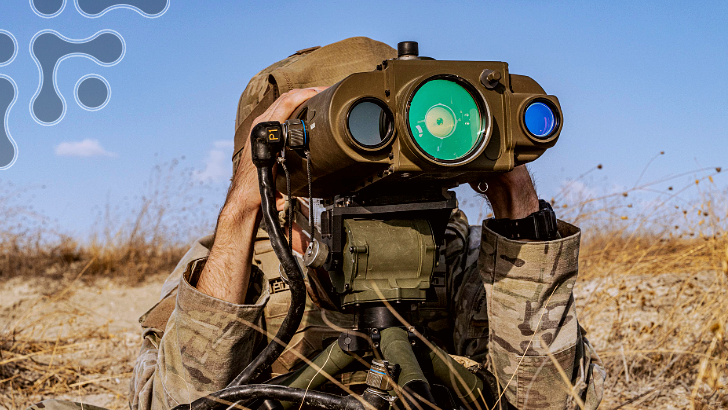

Develop and optimize designs for near-diffraction limited, near-infrared Photonic Crystal Surface-Emitting Lasers (PCSEL) laser diode arrays; a multi-element, surface-emitting, semiconductor laser structure with single-spatial-mode emission. Devices must output sufficient intensity to be used in various laser-based efforts for the U.S. Army, including solid state laser pumping and direct illumination across near-infrared wavelengths.
The U.S. Army uses lasers in many of its mission areas and would greatly benefit from a low cost, efficient laser source with high beam quality such as the PCSEL. The Army uses Near Infrared (NIR) lasers, in conjunction with night vision goggles, during night operations for target pointing/marking, precision fires, and target handoff. The NIR PCSEL can be developed to replace the existing edge emitter laser diode. The PCSEL device would be more compact, lighter weight, and less costly due to the PCSELs easy to manufacture planar structure, greatly improved beam quality, and reduced need for beam shaping and steering optics.
The Army also uses compact solid-state lasers in laser rangefinders, for target marking/handoff, designation, and threat detection. These lasers use doped glass or crystal that are pumped by edge-emitting laser diodes. The edge-emitting lasers are highly asymmetric and highly divergent emission must be shaped by optical lenses in order to make it similar in profile to the round optical mode of the laser, as required to achieve good pump-mode overlap and high laser efficiency.
This topic is accepting Phase I proposals for a cost up to $250,000 for a 6-month period of performance. This research effort will require the design and optimization and fabrication of proof-of-concept of NIR PCSELs for use in U.S. Army applications. Develop PCSEL designs that meet program requirements as stated in the description portion of this topic, optimizing for beam quality. Results of modeling shall be provided as well as a manufacturing feasibility study. Metrics such as wavelength, power, duty cycle, efficiency, and beam quality should meet program objectives. Prior work in surface emitting laser diodes and photonic crystal meta-structures should be noted.
Fabricate and deliver >10 proof-of-concept PCSELs of several configurations (multiple near-infrared wavelengths and emitter areas) to validate model and allow selection of best design. These devices should demonstrate significantly improved (>10x) beam quality over existing commercial laser diodes. The packaging should allow them to be easily powered with existing laser diode drivers and integrated into a benchtop laser characterization system.
Lidar, range-finding, illumination, identification, threat detection
For more information, and to submit your full proposal package, visit the DSIP Portal.
SBIR|STTR Help Desk: usarmy.sbirsttr@army.mil

References:
KEYWORDS: Semiconductor laser; Laser diodes; Illuminators; Photonic crystals; Sources
Develop and optimize designs for near-diffraction limited, near-infrared Photonic Crystal Surface-Emitting Lasers (PCSEL) laser diode arrays; a multi-element, surface-emitting, semiconductor laser structure with single-spatial-mode emission. Devices must output sufficient intensity to be used in various laser-based efforts for the U.S. Army, including solid state laser pumping and direct illumination across near-infrared wavelengths.
The U.S. Army uses lasers in many of its mission areas and would greatly benefit from a low cost, efficient laser source with high beam quality such as the PCSEL. The Army uses Near Infrared (NIR) lasers, in conjunction with night vision goggles, during night operations for target pointing/marking, precision fires, and target handoff. The NIR PCSEL can be developed to replace the existing edge emitter laser diode. The PCSEL device would be more compact, lighter weight, and less costly due to the PCSELs easy to manufacture planar structure, greatly improved beam quality, and reduced need for beam shaping and steering optics.
The Army also uses compact solid-state lasers in laser rangefinders, for target marking/handoff, designation, and threat detection. These lasers use doped glass or crystal that are pumped by edge-emitting laser diodes. The edge-emitting lasers are highly asymmetric and highly divergent emission must be shaped by optical lenses in order to make it similar in profile to the round optical mode of the laser, as required to achieve good pump-mode overlap and high laser efficiency.
This topic is accepting Phase I proposals for a cost up to $250,000 for a 6-month period of performance. This research effort will require the design and optimization and fabrication of proof-of-concept of NIR PCSELs for use in U.S. Army applications. Develop PCSEL designs that meet program requirements as stated in the description portion of this topic, optimizing for beam quality. Results of modeling shall be provided as well as a manufacturing feasibility study. Metrics such as wavelength, power, duty cycle, efficiency, and beam quality should meet program objectives. Prior work in surface emitting laser diodes and photonic crystal meta-structures should be noted.
Fabricate and deliver >10 proof-of-concept PCSELs of several configurations (multiple near-infrared wavelengths and emitter areas) to validate model and allow selection of best design. These devices should demonstrate significantly improved (>10x) beam quality over existing commercial laser diodes. The packaging should allow them to be easily powered with existing laser diode drivers and integrated into a benchtop laser characterization system.
Lidar, range-finding, illumination, identification, threat detection
For more information, and to submit your full proposal package, visit the DSIP Portal.
SBIR|STTR Help Desk: usarmy.sbirsttr@army.mil
References:
KEYWORDS: Semiconductor laser; Laser diodes; Illuminators; Photonic crystals; Sources
